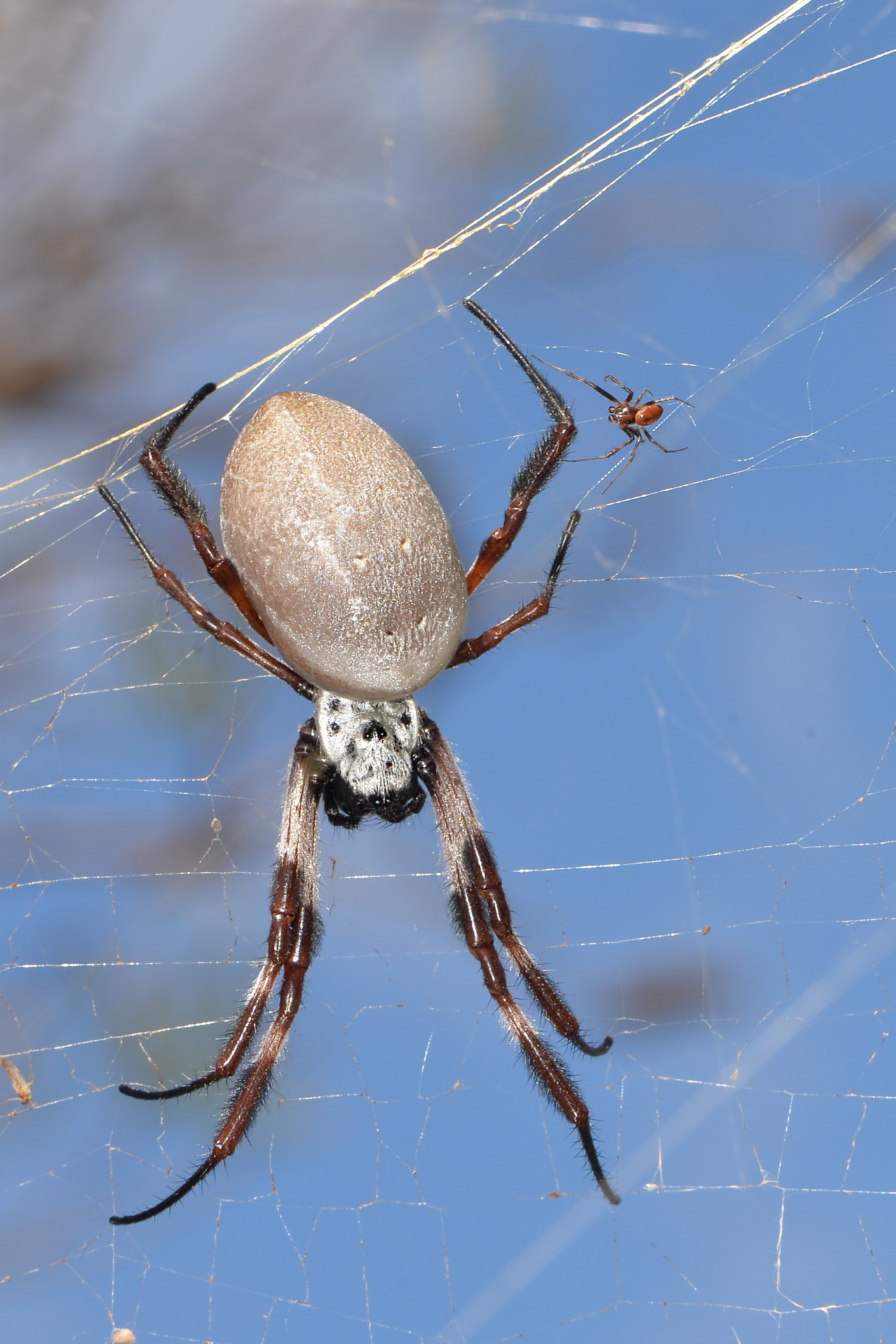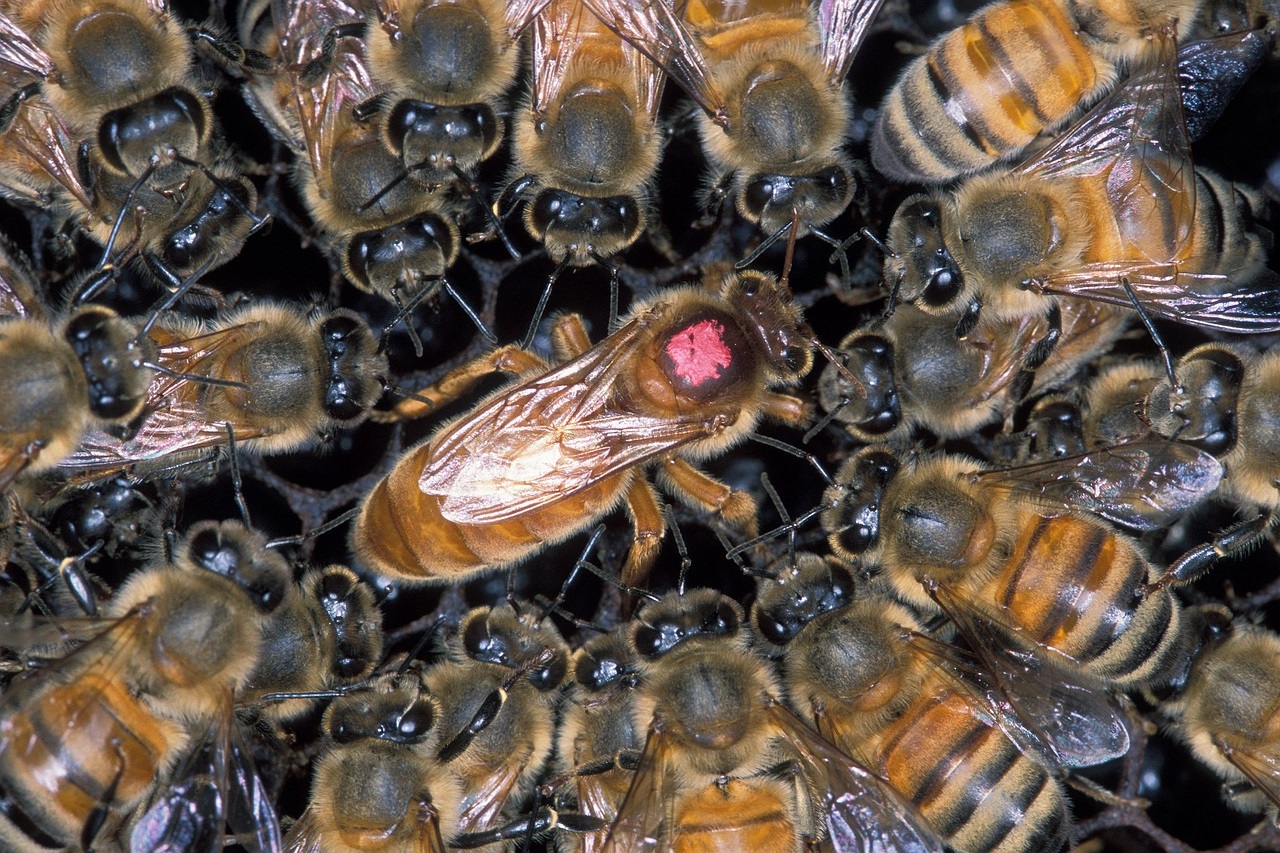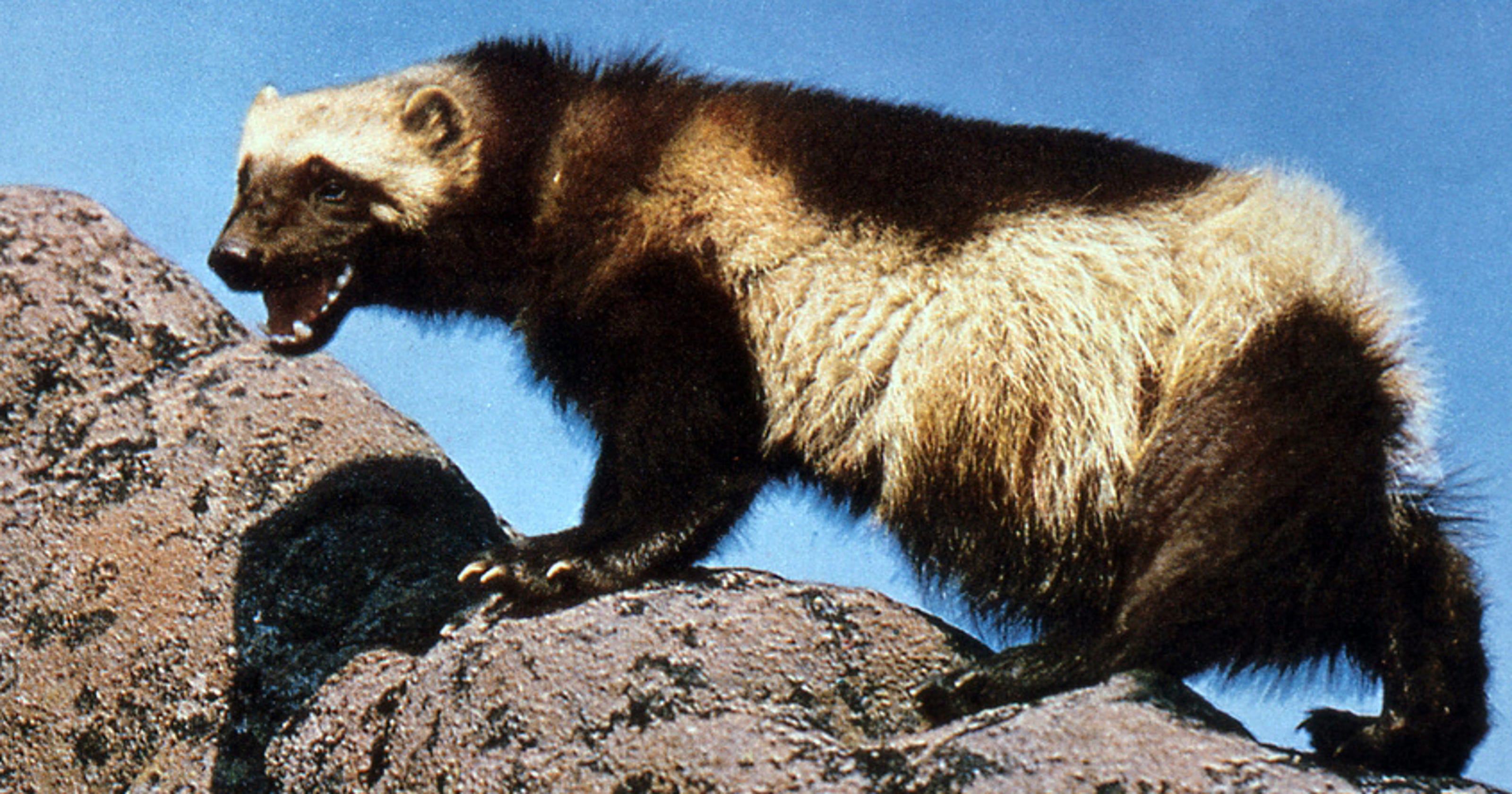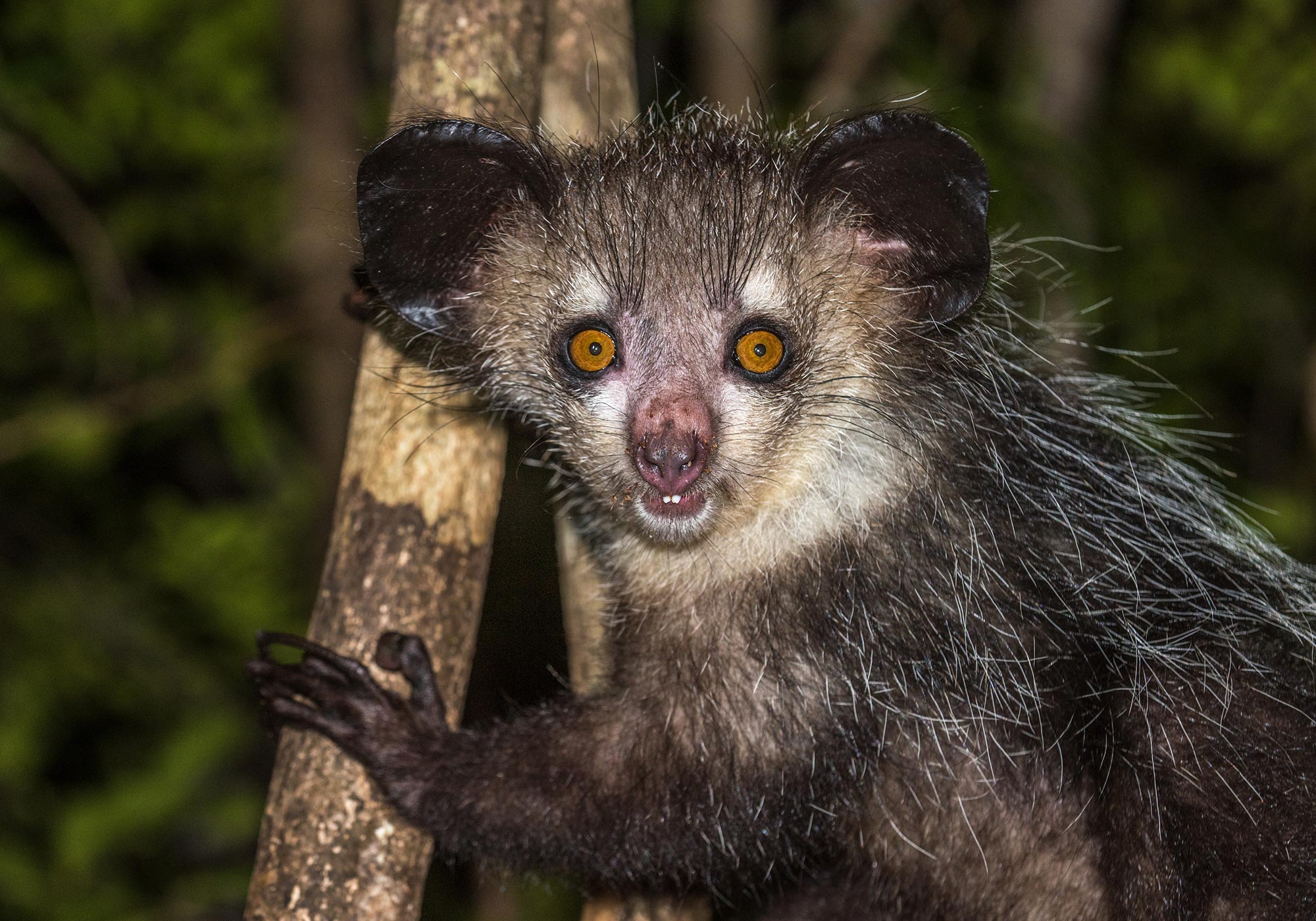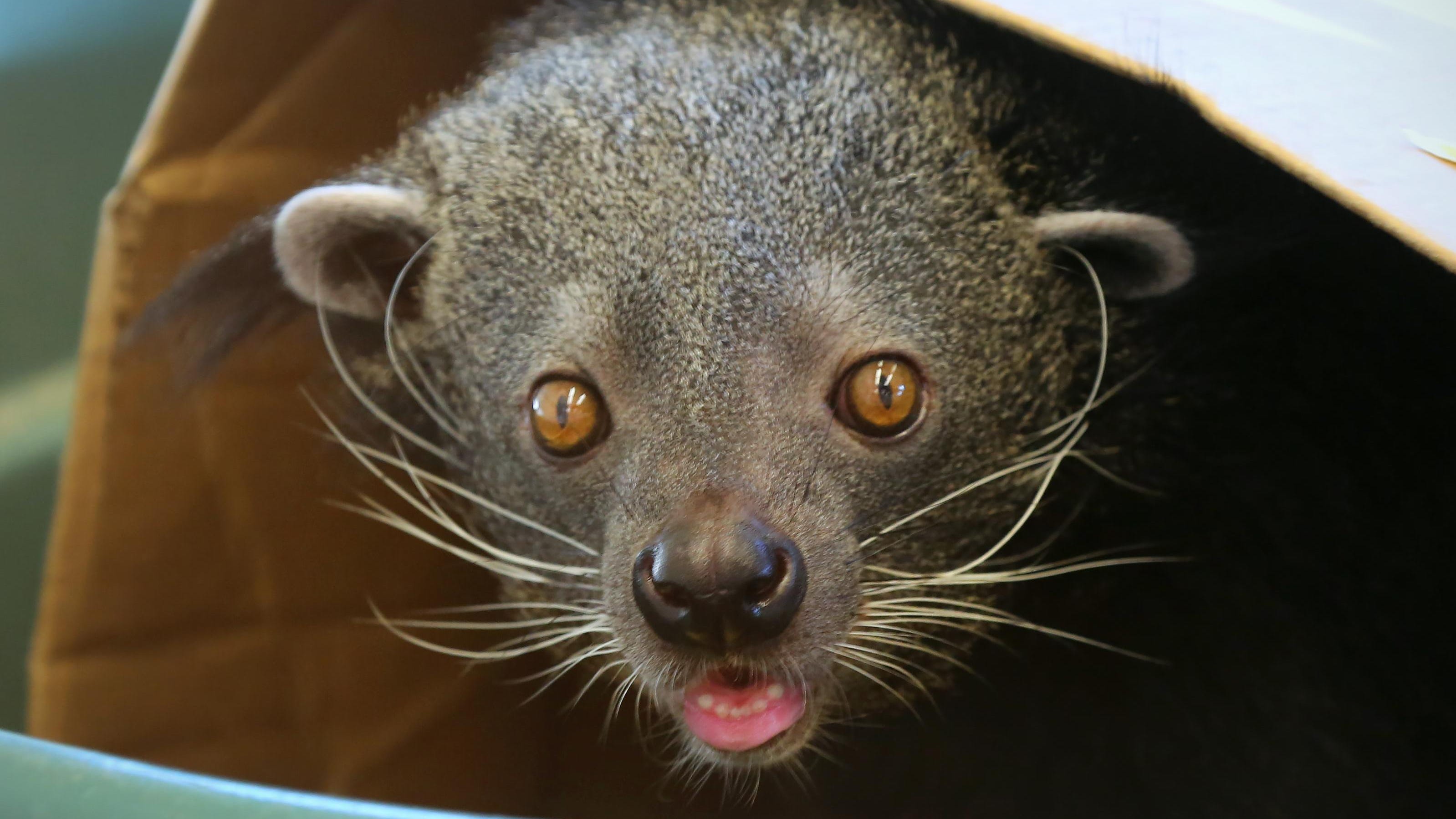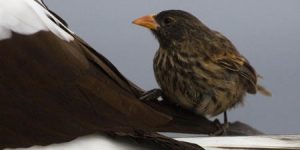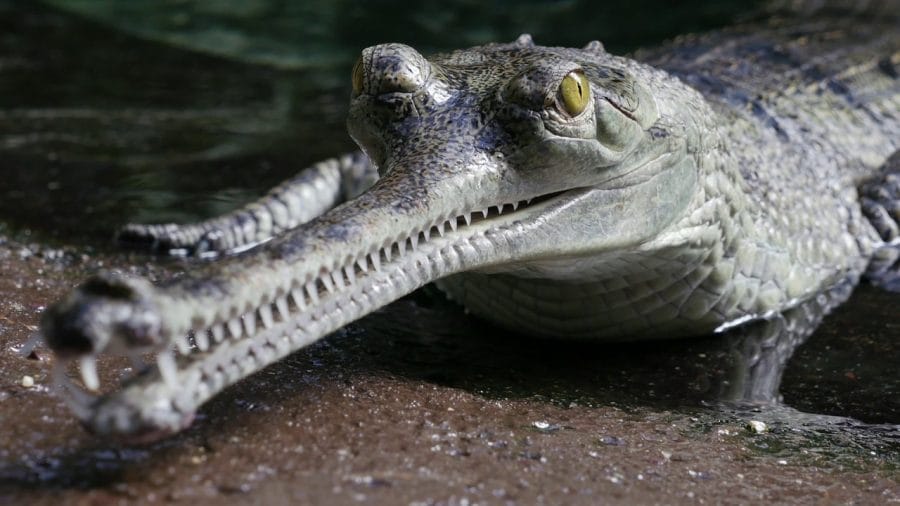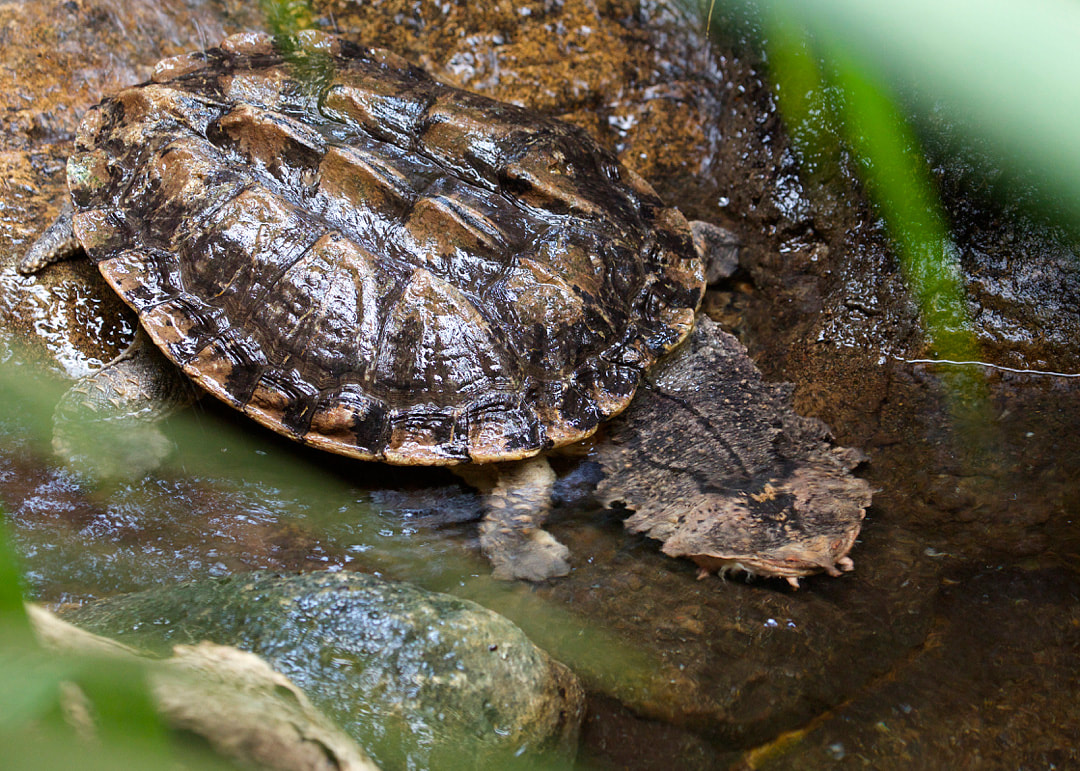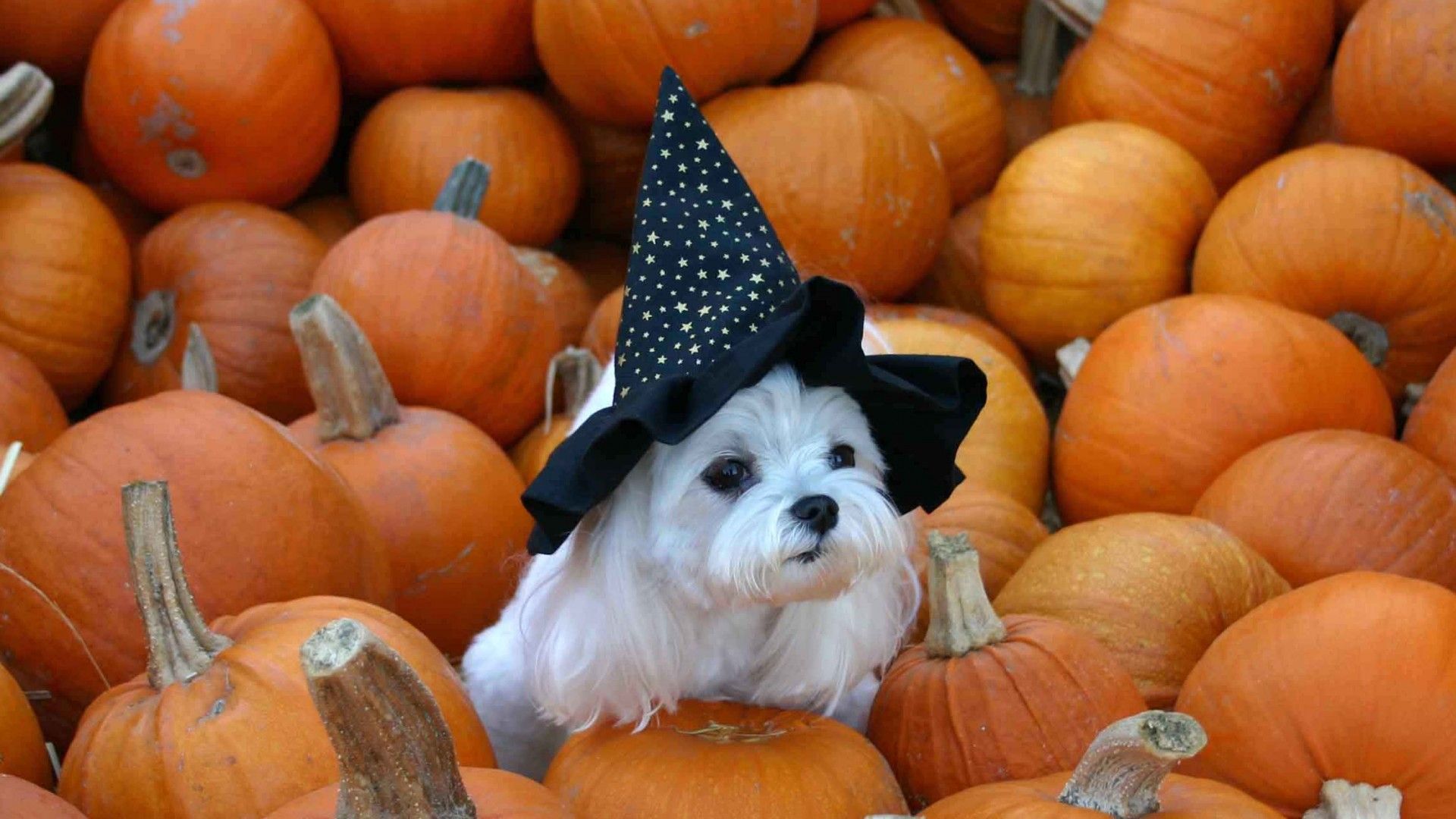An E.B.W. Critter Corner Special Halloween Edition
A Halloween Extravaganza Part 3
Creepy Bugs, Insects, & Arachnids
"40. Goliath Birdeater Spider
Latin name: Theraphosa blondi
Scary feature: Huge & has long fangs, stinging barbs
Range: South America
Size: Body length: 4.7 inches (12 cm); Leg span: 12 inches (30 cm); Fang length: 1.5 inches (3.8 cm)
Diet: Earthworms, insects, frogs, & occasionally small birds
The Goliath birdeater is one of the largest & heaviest spiders in the world. It’s also hairy & has fangs that grow longer than an inch in length.
It earned its bird-eater name after being observed eating a hummingbird, but it usually eats worms & frogs. It does have venom but harmless to humans...
41. Malaysian Jungle Nymph
Latin name: Heteropteryx dilatata
Scary feature: Huge insect with spiky legs
Range: Malay Peninsula
Size: Length: 4 to 6 inches (10 to 15 cm); Weight: 2.29 ounces (65 grams)
Diet: Bramble, oak, ivy, raspberry, blackberry, & other leaves
Stick bugs are fascinating creatures, but have you ever seen the Malaysian jungle nymph? It’s huge! It’s one of the heaviest insects in the world.
Like the smaller versions, it resembles a green leaf or brown twig. It also lays the largest egg of any insect which is about 0.5 inches (1.3 cm) in length.
42. Bot Fly
Latin name: Oestridae
Scary feature: Can grow its larvae in human flesh
Range: Central & South America
Size: Length: 0.05 inches (0.127 cm)
Diet: Adults don’t eat, but larvae eat blood cells of its host
...the botfly is one of the creepiest bugs on the planet.
It’s best known for laying its eggs on a mosquito which then transfers the larvae to flesh including that of humans.
The larvae grow inside the flesh & can cause skin lesions & infections. It’s absolutely disgusting & horrifying...
43. Black Widow Spider
Latin name: Latrodectus mactans
Scary feature: Red hour-glass marking & potent venom
Range: North & South America
Size: Length: 1.5 inches (3.8 cm); Diameter: 0.25 inches (0.64 cm)
Diet: Flies, mosquitoes, beetles, centipedes, grasshoppers, caterpillars, & other spiders
Considered North America’s most venomous spider, the black widow is distinguished by the red hourglass-shaped marking on its abdomen, & it’s the low-cut leather catsuit…
Black widow venom is believed to be 15 times more powerful than a rattlesnake, causing vomiting, abdominal pain, & even death.
Fortunately, black widow bites are rare because this spider is shy & timid...
44. Mexican Red-kneed Tarantula
Latin name: Brachypelma smithi
Scary feature: Orange leg joints & venomous fangs
Range: Pacific coast of Mexico
Size: Body length: 4 inches (10cm); Leg span: 6 inches (15 cm); Weight: 0.53 ounces (15 g)
Diet: Insects, crickets, small frogs, small lizards, & mice
The Mexican red-kneed tarantula is a black, hairy spider that gets its name from the reddish-orange patches on its leg joints.
It does have venomous fangs used to kill prey, but it isn’t any more harmful to a human than a bee sting.
Its docile nature makes it the most popular pet tarantula in the world...
45. Giant Desert Centipede
Latin name: Scolopendra heros
Scary feature: Huge creepy crawly with a painful bite
Range: Mexico & Southwest United States
Size: Length: Up to 8 inches (20 cm)
Diet: Worms, crickets, snails, roaches, mice, frogs, lizards, & small birds
While there are some pretty big centipedes in the world, but the Amazon giant centipede is the largest, growing up to a foot long.
It has a reddish-brown body with 40 yellow legs. It delivers venom from its front pincers that can cause bad pain, redness, & swelling but nothing more serious to humans.
46. Golden Orb Spiders
Latin name: Nephila clavipes
Scary feature: Venomous
Range: Southern United States, Africa, Asia, & Australia
Size: Length: Up to 5 inches (12.7 cm) including legs
Diet: Mosquitoes, bees, butterflies, flies, moths, wasps, grasshoppers, stink bugs
The golden orb spider, also called the banana spider, is a colorful spider of red, yellow & black.
It’s known to spin intricate, orb-shaped webs that are distinctively golden in color & can stretch a meter in width.
This spider is mildly venomous, causing pain, redness, & blisters at the bite location.
47. Lobster Moth Caterpillar
Latin name: Stauropus fagi
Scary feature: Forelegs like lobster claws
Range: Worldwide
Size: Length: Up to 2.75 inches (70 mm)
Diet: Plant leaves
...It’s named after the lobster because its long forelegs look like lobster claws.
And its swollen anal section arches over its back like a lobster that’s about to attack a predator. This is to scare birds away.
48. Tailless Whip Scorpion
Latin name: Amblypygi
Scary feature: Legs that resemble whips
Range: North & South America, Asia, & Africa
Size: Length: 4 to 10 inches (10 to 25 cm)
Diet: Insects
The tailless whip scorpion is not a scorpion at all but looks like a combination of a scorpion & a spider.
It is so named because of its lack of a tail & 'whip-like' front legs that are much longer than its body. It’s not venomous & poses no threat to humans.
49. Tarantula Hawk
Latin name: Pepsis thisbe
Scary feature: Feeds tarantulas to its larvae
Range: Every continent except Europe & Antartica
Size: Length: Up to 2 inches (5mm)
Diet: Nectar, flowers, & tarantulas
The tarantula hawk is a large wasp with a blue body & orange wings. Commonly found in the Grand Canyon, it feeds on nectar & pollen.
However, the female captures tarantulas to feed to her larvae – earning them their name.
It won’t sting unless threatened, but when it does, the sting is considered one of the most painful of any insect.
50. Milkweed Assassin Bug
Latin name: Zelus longipes
Scary feature: Disease-causing saliva
Range: Southern North America, Central America, & South America
Size: Length: 0.5 to 1.5 inches
Diet: Blood of other insects (& sometimes humans)
...The milkweed assassin bug a dangerous pretender. It tries to look & act just like the harmless milkweed bug that feeds only on insects.
It does this to attract other insects so it can stab them with its large fang & drink their blood.
It has venomous saliva that can spread infectious diseases, Chagas, in humans.
51. Japanese Giant Hornet
Latin name: Vespa mandarinia japonica
Scary feature: Extremely painful sting & kills whole bee colonies
Range: Japan
Size: Length: 1.6 to 1.8 inches; Wingspan: 2.4 inches
Diet: Honey bees, wasps, praying mantises, & other insects
The Japanese giant hornet has a painful sting that’s capable of sending you to the hospital!
Usually, the only people who need fear this hornet are beekeepers because it especially loves eating bee larvae.
Along with several of its buddies, it can invade & massacre a whole bee colony in just a couple of hours.
52. Africanized Bee (Killer Bees)
Latin name: Apis mellifera scutellata
Scary feature: Extremely aggressive with a lethal sting
Range: United States, Central, & South America
Size: Length: 0.50 inches (1.27 cm)
Diet: Pollen
Also called killer bees, Africanized bees are the result of a man-made experiment that involved crossbreeding a European honey bee with an African honey bee.
The offspring, killer bees, are extremely aggressive with a lethal sting that’s killed more than 1,000 humans. They react in swarms & will chase their victims & sting repeatedly.
53. Emperor Scorpion
Latin name: Pandinus imperator
Scary feature: Huge size & massive claws
Range: West Africa
Size: Length: Up to 7.9 inches (20 cm)
Diet: Insects
This guy’s fear factor pretty much ends with the creepy appearances. One of the largest scorpions in the world, the emperor scorpion grows up to almost 8 inches in length.
It looks glossy black but glows blue or green under ultraviolet rays. It has massive red claws that it uses to grab prey.
It has a stinger & produces a mild venom that is not considered dangerous to humans.
54. Mosquitoes
Latin name: Culicidae
Scary feature: Deadliest animal in the world
Range: Worldwide
Size: Length: 0.11 to 0.24 inches (3 to 6 mm)
Diet: Nectar & blood
Can you guess what’s the most deadly animal on the planet? The tiny mosquito!
Because its saliva can carry viruses & bacteria, it can transmit a long list of diseases that spread worldwide such as malaria, dengue, West Nile virus, Zika virus & more.
According to the World Health Organization, more than a million people die each year to these diseases, & even more millions are affected."
Scariest Mammals
55. Wolverine
Latin name: Gulo gulo
Scary feature: Sharp claws, powerful jaws, & ferocious attitude
Range: Northern Canada, Alaska (USA), Nordic European countries & western Russia & Siberia
Size: Length: 32.7 to 52.2 in. (82 to 133 cm); Weight: 12 to 55 lbs (5.5 to 25 kg)
Diet: Carrion, mammals, birds & their eggs, roots, berries, seeds, insect larvae
...The wolverine is the largest land-dwelling species of the weasel family.
It has a stocky, muscular build & a broad head, short snout, & bushy tail. To top it off, the wolverine also has sharp claws, & powerful, bone-cracking jaws...
It’s a fearless beast with a reputation of killing prey much larger than itself. Fortunately, there are no reports of attacks on humans.
56. Aye-Aye
Latin name: Daubentonia madagascariensis
Scary feature: Large ears, creepy fingers & eyes that glow in the dark
Range: Madagascar
Size: Length: 14 to 17 in; Tail: 22 to 24 in; Weight: 4 to 6 lbs
Diet: Insects, larvae, fruit, seeds, fungi
Some scary animals are weirdly cute. Take the aye-aye for example. It looks like it could’ve been the inspiration for the Gremlins because of its large ears & eyes (which glow in the dark, of course) & long, weird fingers.
This furry creature happens to be the world’s largest nocturnal primate plus the world’s only primate that uses echolocation.
57. Naked Mole Rat
Latin name: Heterocephalus glaber
Scary feature: Pink, naked rat-like animal
Range: Horn of Africa (Kenya, Ethiopia & Somalia)
Size: Length: 5.1 in; Weight: 1.2 to 2.8 oz
Diet: Roots & tubers
Neither a mole nor a rat, the naked mole rat has pink, wrinkled skin with only a few hairs on its tail & head that feature sensitive nerves that help with navigating in dark, underground tunnels.
Much can be learned from this creature that may benefit humans because it’s resistant to cancer & can survive hours with little oxygen.
58. Tube-nosed Fruit Bat
Latin name: Nyctimene albiventer
Scary feature: Weird, tubular nose
Range: Eastern Australia, Indonesia, Papua New Guinea, Philippines, & the Solomon Islands
Size: Length: 3.2 in ( 8 cm); Weight: 1.1 oz ( 31 g)
Diet: Fruits, nectar, flowers, & pollen
The tube-nosed fruit bat looks sort of spooky-cute. It gets its name from its weird, tubular nostrils.
But adding to its odd appearance are the protruding eyes that glow red, a short blunt snout, & yellow spots on the ears & wings.
It’s a perfectly harmless creature that feeds on flowers, nectar, & pollen.
59. Cape Buffalo
Latin name: Syncerus caffer
Scary feature: Enormous horns & aggressive behavior
Range: Central & Southern Africa
Size: Height: 51 to 59 in (130 to 150 cm); Weight: 935 to 1,910 lbs (425 kg to 875 kg)
Diet: Grass, shrubs, insects
The Cape buffalo is best known for its enormous, curving horns that can span 4 ft wide. It can weigh nearly a ton & is extremely aggressive.
If any individual is threatened, the whole herd will charge the offender. It’s estimated that approximately 200 people die each year from Cape buffalo attacks.
60. Star-nosed Mole
Latin name: Condylura cristata
Scary feature: Face tentacles & huge claws
Range: Eastern Canada & the eastern United States
Size: Length: 4.6 in ( 12 cm); Weight: 1.7 oz ( 48 g)
Diet: Small insects, fish, worms & other invertebrates
Star-nosed moles... have 22 pink tentacles coming out of their face in the shape of a star.
These tentacles have 100,000 nerve fibers, making their 'stars' the most sensitive touch organ of any other mammal.
They also have huge, shovel-like claws & can eat faster than any other earthling mammal...
61. Hippopatoumous
Latin name: Hippopotamus amphibius
Scary feature: Massive size, gaping mouth, & huge teeth
Range: Africa
Size: Length: 10 to 16.5 ft (3.3 to 5 m); Height: 5.2 ft (1.6 m) tall at the shoulder; Weight: 3,000 to 9,920 lbs (1,400 to 4,500 kg)
Diet: Grass & fruits but sometimes animal carcasses
It may look fat and sluggish, but the hippo is the world’s most dangerous land mammal, killing about 500 people each year in Africa.
It doesn’t eat people because it’s an herbivore, but it’s highly aggressive and doesn’t like intruders.
Its enormous weight, gaping mouth, huge teeth, & quick speed all create a mighty force.
62. Bearcat
Latin name: Arctictis binturong
Scary feature: Looks part bear & part wildcat
Range: Southeast Asia
Size: Length: 2 to 3 ft (61 to 91 cm); Weight: 25 to 31 lbs (11 to 14 kg)
Diet: Fruit, leaves, shoots, eggs, fish, small mammals, birds, & carrion.
...The bearcat has the stocky shape of a bear & a face like a wildcat with long, white whiskers.
It also has sharp claws, black tufts on its ears, & a long, bushy tail that it uses to wrap around tree branches. If you don’t see it at first, you may hear its high-pitched growl.
63. Honey Badger
Latin name: Mellivora capensis
Scary feature: Fearless behavior & sharp claws & teeth
Range: Sub-Saharan Africa, India, Western Asia, & the Arabian peninsula
Size: Body length: 2.4 ft (73 cm); Tail length: 12 in (30 cm); Weight: 19 to 26 lbs (9 to 12 kg)
Diet: Honey, honey bee larvae, snakes, scorpions, tortoises, mammals, birds, eggs, berries, & roots
The honey badger loves honey...This member of the weasel family has been called the 'world’s most fearless animal.'
Covered in fur & a thick hide that’s almost impossible to pierce, this badger also has really sharp teeth & claws.
It doesn’t think twice about chasing away lions & attacking a whole beehive of killer bees.
64. Black Flying Fox
Latin name: Pteropus alecto
Scary feature: Nothing scary here except scary myths
Range: Australia, Papua New Guinea, & Indonesia
Size: Length: 6.46 in (16 cm); Weight: 1.57 lbs (0.71 kg); Wingspan: 3 ft (1 m)
Diet: Fruit, nectar, & pollen
The black flying fox is actually a black bat that has a reddish-brown mantle like a fox.
...It has a really long tongue that’s used to eat fruit, & it’s among the world’s largest species of bats.
65. Vampire Bats
Latin name: Desmodontinae
Scary feature: Sucks the blood of birds & livestock (rarely humans)
Range: Mexico, Central, & South America
Size: Height: 2.75 to 3.75 in (7 to 9.5 cm); Weight: 0.7 to 2 oz (19 to 57 g); Wingspan: 5.9 to 7 in (15 to 18 cm)
Diet: Blood
Yes, these bats drink blood from birds & livestock, but the amount is very little considering that they are only about the size of a human thumb.
Vampire bats really don’t deserve their fearsome reputations.
They find their food by heat sensors on their noses, & they will regurgitate their blood consumption to share with starving colony members.
Scary Birds
66. Marabou Stork
Latin name: Leptoptilos crumenifer
Scary feature: Decaying flesh appearance
Range: Sub-Saharan Africa
Size: Height: 5 ft (1.52 m); Weight: 20 lbs (9 kg); Wingspan: 11 ft (3.35 m)
Diet: Carrion
Nicknamed the 'undertaker,' the marabou stork is associated with death. In addition to its preference for eating dead animals, the marabou stork even looks like death.
With its rotting-like head, flabby wattle, skinny, poop-stained legs, cloak-like wings, & hunched-over posture, it’s no wonder this bird is sometimes called the 'Grim Reaper.'
67. Bearded Vulture
Latin name: Gypaetus barbatus
Scary feature: It eats the bones of the dead.
Range: Europe, Asia, & Africa
Size: Length: 37 to 49 in (94 to 125 cm); Weight: 9.9 to 17.2 lbs (4.5 to 7.8 kg); Wingspan: 7.6 to 9.3 ft (2.31 to 2.83 m)
Diet: Bones of other animals
With its massive, hulking figure, rusty-colored feathers, scruffy black beard, black eye band, & yellow-red eyes, the bearded vulture is a scary sight.
Its diet is even creepier because it feeds primarily on the bones of dead animals. This vulture has one of the strongest stomach acids in the world.
So, as long as you’re alive, you need not fear the bearded vulture.
68. California Condor
Latin name: Gymnogyps californianus
Scary feature: Huge wingspan, naked head & red eyes
Range: California, Arizona, Utah
Size: Length: 43 to 55 in (109 to 140 cm); Weight: 18 to 20 lbs (8 to 9 kg); Wingspan: 10 ft (3.05 m)
Diet: Carrion
Even though the California condor stays clear of humans (unless you’re dead), this carcass-eating scavenger presents a dominating appearance with its bare, pink head, red eyes, & a black feather ruff around its neck.
Plus, it’s sometimes confused with a small airplane because it has the largest wingspan of any North American bird (10 ft).
69. Potoo
Latin name: Nyctibius
Scary feature: Bulging yellow eyes & haunting growl
Range: Central & South America
Size: Length: 19 to 24 in (48 to 61 cm): Weight: 13 to 23 oz (360 to 650g); Avg. Wingspan: 29 in (74 cm)
Diet: Large flying insects (beetles, moths, grasshoppers)
Another of the scary animals that look oddly cute is the potoo. You won’t see it during the day because its mottled gray/green plumage camouflages it while it snoozes in the trees.
However, at night, when the potoo comes out to hunt for insects & bats, its bulging, yellow eyes & loud, haunting growl will scare the bejeebers out of you.
70. Helmeted Hornbills
Latin name: Rhinoplax vigil
Scary feature: Creepy casque, red throat patch & scary laugh
Range: Malay Peninsula, Sumatra, & Borneo
Size: Length: 43 to 47 in (110 to 120 cm); Weight: 6 to 6.8 lbs (2.6 to 3.1 kg)
Diet: Fruits (especially figs) & insects
There’s a Punan myth that says this hornbill guards the river between life & death.
It certainly looks dressed for the job with its natural 'headgear,' that heavy, weird-looking, helmet/casque thing on its head that it uses in combat with other birds.
Even more creepy is its red, bare throat patch. If its appearance doesn’t keep you on your side of the river, its maniacal laugh may send you running...
71. Southern Cassowary
Latin name: Casuarius casurarius
Scary feature: Razor-sharp claws on its feet
Range: Australia
Size: Height: 5 to 6 ft (1.5 to 2 m); Weight: 125 lbs (57 kg)
Diet: Fruit, berries, fungi & the occasional rodent, snail or lizard
You should be wary of the southern cassowary, & it’s not just because it’s a tall, huge bird with a royal blue neck, hairy black feathers, & a weird-looking helmet-like casque over its eyes.
It’s because it has razor-sharp claws on its feet that can cause serious wounds, making it the most dangerous bird in the world.
72. Vampire Finch Bird
Latin name: Geospiza difficilis septentrionalis
Scary feature: Drinks the blood of other birds
Range: Galápagos Islands
Size: Length: 1 in (less than 3 cm); Weight: 71 oz (20 g)
Diet: Seeds, nectar, invertebrates, & blood of other birds
Finches are usually known to be colorful birds that eat seeds, but on the Galápagos Islands lives the dark-feathered vampire finch which feeds on the blood of other birds.
The vampire finch is known to peck at the wings & tails of booby birds until it draws blood to drink. Oddly enough, the boobies don’t seem to mind at all.
73. Shoebill
Latin name: Balaeniceps rex
Scary feature: Massive bill that resembles a shoe
Range: Central-Eastern Africa
Size: 43-55 in (110 to 140 cm); Weight: 11 to 12 lbs (4.9 to 5.4 kg); Wingspan: 7.7 to 8.6 ft (230 to 260 cm
Diet: Lungfish, water snakes, baby crocodiles, lizards, rodents & waterfowl
Standing more than 4 feet high with large feet, a wide wingspan, & a massive bill that looks more like a wooden clodhopper with a razor-sharp hook tacked on the end of it, the shoebill looks like it would be the local swamp bully.
Instead, it’s a quiet loner that remains motionless in the wetlands & patiently waits for its prey to swim to it."
Drew Haines
everywherewild.com/scary-animals
Scary (but Cute) Critters:
Halloween Chuckle:
Happy Halloween!!!




